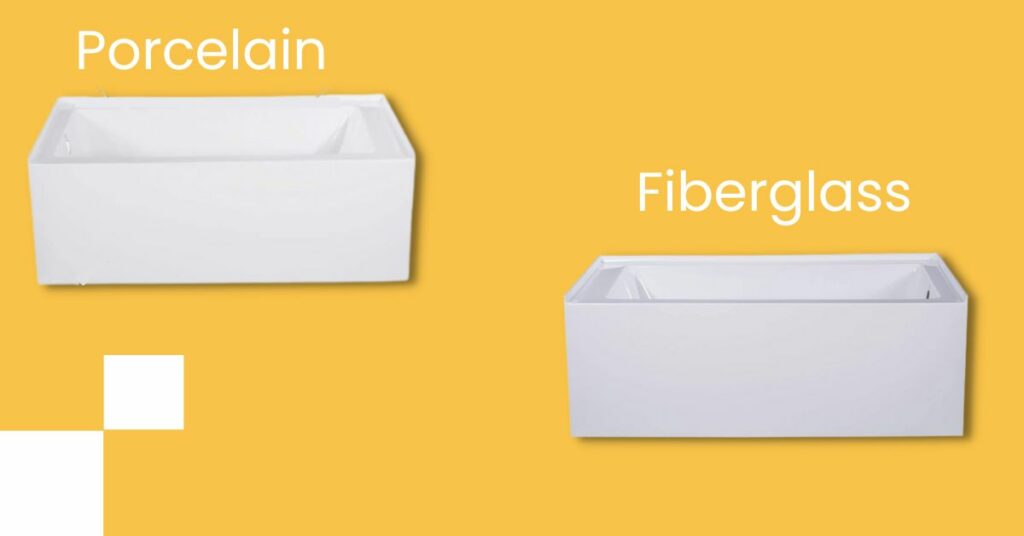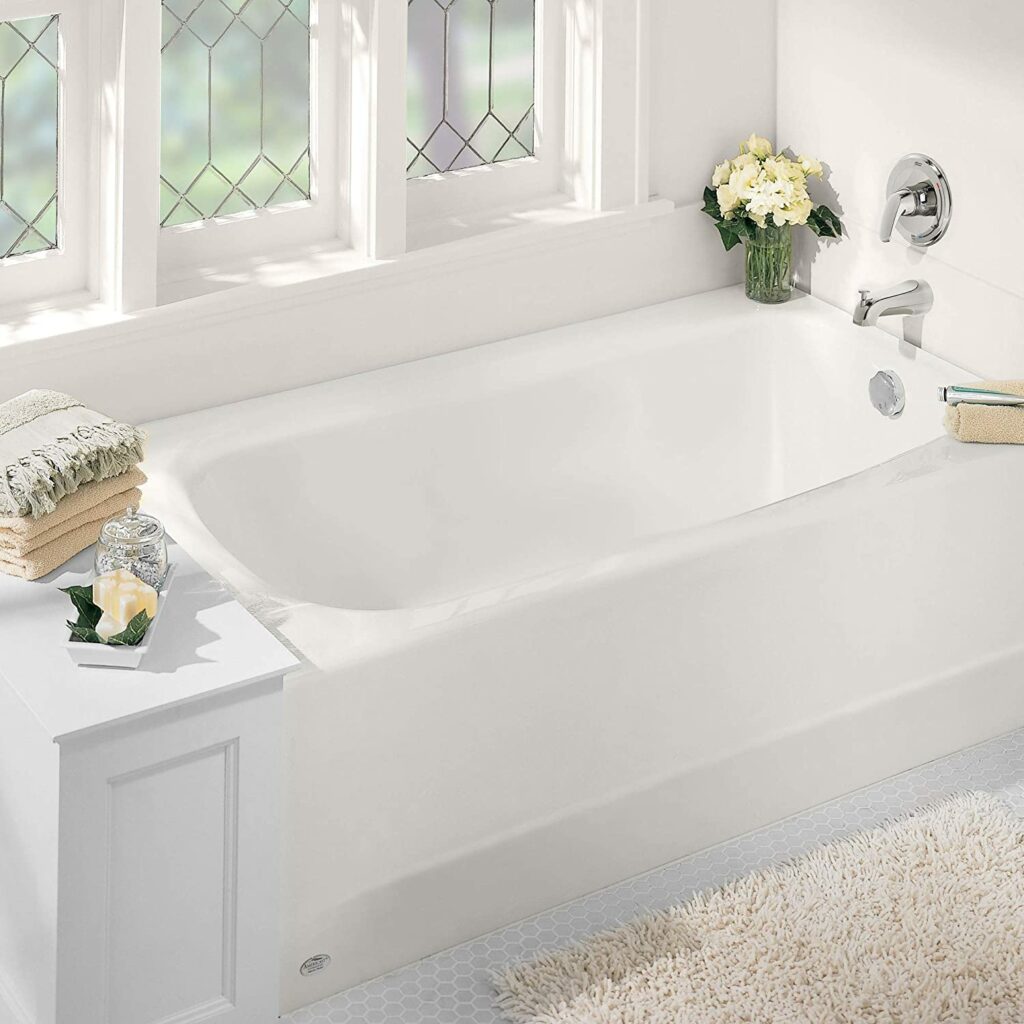What’s the difference between fiberglass and porcelain tubs? That might seem like an easy question to answer, but there are actually quite a few variables that come into play when comparing the two materials. Before you make your decision, it’s important to look at the differences, pros, and cons of each material so you can decide which one is right for your bathroom renovation project.
In this blog, I’ll go over the differences, pros, and cons of Fiberglass tub vs Porcelain to help you decide which type of bathtub you should get for your home.
Use links below for easy navigation
Fiberglass Tub Vs Porcelain
Pros and Cons of Porcelain Vs Fiberglass Tub
Bottom Line
Fiberglass Tub Vs Porcelain

Many people are often surprised to learn that there are many types of bathtubs on the market, with more options available now than ever before. That’s because not all bathtubs are created equal—the material your tub is made from can have a big impact on how it looks, how easy it is to clean, and how much maintenance it requires over time.
Choosing between fiberglass and porcelain bathtubs can be tough, but understanding the benefits of each one will help you make the right choice.
Here we will discuss the differences between fiberglass and porcelain tubs
Costs
Fiberglass baths are typically less expensive than porcelain ones. The cost of installation is also lower with a fiberglass model—an average of $1,000 less than with porcelain.
Fiberglass tubs are generally more affordable than porcelain models and easier to install, so if you’re looking for something that’s going to last a long time without much work on your part, this material may be the way to go.
Ease of installation
Fiberglass tubs can be installed without plumbing work or structural changes to your home, while porcelain tubs require more work and sometimes even structural changes.
Durability
Both types of tubs can last many years if properly maintained, but porcelain will last longer than fiberglass because it is made from stronger materials and has no joints that can crack over time. If you want something that will stand up against wear and tear, then choosing a porcelain model might be the better option for you.
Related: Acrylic vs Porcelain Tub
Quality and materials
Fiberglass tubs are made from a material called glass-reinforced plastic (GRP), which is molded into a shape that resembles a traditional tub. They have a smooth surface and tend to be lighter than porcelain models, making them easier to move around and install.
On the other hand, porcelain tubs are made from ceramic-coated metal. Porcelain is also denser than fiberglass so it tends to be heavier than fiberglass but also more durable.
Resistant to damage
Porcelain tubs are more resistant to moisture damage than fiberglass tubs because they have a hard surface that resists staining and discoloration better than fiberglass; however, this also means that cleaning them can be more difficult unless you use special cleaning products designed for porcelain surfaces.
Look and feel
The main difference between fiberglass and porcelain tubs is their look. A Porcelain bathtub is shiny, bright white, and can be decorated with glass etchings or other decorations. Fiberglass is usually a matte white or brown color.
Cleaning
Fiberglass tubs are better for cleaning, as they’re easier to clean and don’t retain bacteria as much as a porcelain tub.
Maintenance costs
Fiberglass tubs are often used in bathrooms that have had a lot of traffic, or in areas that need to withstand high usage. Also, they don’t require as much maintenance as a porcelain tub, and they are also less expensive.
Weight
Porcelain is also heavier than fiberglass so it may be harder to install yourself without professional help from a contractor or even just someone who has experience doing this kind of work before!
Heat retention
Porcelain retains heat better than fiberglass does because of its composition as well as how it’s manufactured (it’s fired at high temperatures). This means that anyone who suffers from arthritis or joint pain may find that they get more relief from soaking in water heated by porcelain than they would from soaking in water heated by fiberglass.
Related: Japanese soaking tubs
Appearance
Porcelain tubs are more likely to be made in a variety of colors, so if you’re looking for something that will match your bathroom décor, porcelain may be a better option. Fiberglass tubs tend to come in only one or two colors.
Choosing between fiberglass and porcelain
Fiberglass tubs are less expensive than porcelain ones and they are easy to install. They are also easy to repair in case of any damage. However, fiberglass tubs do not last as long as porcelain ones which can last for decades if well taken care of. Also, fiberglass tubs do not retain heat very well either so you will need to use more hot water to fill the tub. This can make them more expensive than porcelain tubs in the long run because you will need to use more energy when filling them.
Pros and Cons of Porcelain Vs Fiberglass Tub

For the past century or so, porcelain tubs have been the go-to choice for homeowners looking to replace their tubs. But today, modern technology has resulted in some incredible innovations that can help you make your bathroom look and function better than ever before.
If you’re considering making an update to your bathtub, we’ll help you weigh the pros and cons of both fiberglass tubs and porcelain tubs to help you figure out which one best fits your needs and preferences.
Fiberglass tub Pros and Cons

Fiberglass bathtubs are a great choice for your home. Fiberglass tubs are made with a combination of plastic and glass fibers. A fiberglass tub is a great choice if you want a high-quality bathroom fixture that won’t break the bank or take up all of your time maintaining it.
Less expensive and durable
Fiberglass tubs are much less expensive than other types of tubs. This is especially true when you consider the amount of time you’ll save on installation and maintenance. The material is durable and will last for years if properly cared for.
Easy Installation
Fiberglass tubs are much easier to install than other types of tubs; you don’t need any special tools or skills. The only thing you need is a screwdriver and some patience while you wait for it to cure. There’s no need for mortar or grout—you can even use silicone caulk if you’re feeling lazy!
Low Maintenance
Maintenance is also an important factor when choosing a new bathtub: you want something that won’t require much work on your part. And fiberglass can be easily cleaned with soap and water.
Prone to cracking
Fiberglass tubs are prone to cracking, if you drop a heavy thing, they can easily get cracked or chipped which can be really frustrating.
Porcelain tub Pros and Cons

Porcelain tubs are made of ceramic, which makes them extremely durable. They won’t crack or break as fiberglass or acrylic tubs can. This makes them a great option if you have young children or pets in your home who are likely to bang against the tub.
Let’s take a look at the porcelain tub pros and cons.
Durability
The durability of porcelain is unbeatable. It is the most durable material used in bathtubs and sinks, so you won’t have to worry about it cracking or chipping.
Does not crack
Porcelain tubs do not crack or chip like other materials such as acrylic or fiberglass. So, if you have children who tend to play in the tub, this is an excellent choice for them!
Heat retention
When you bathe with hot water, it can help your muscles relax and relieve tension. A porcelain tub will retain heat longer than other types of bathtubs. This means that you can stay warm longer than usual when using your new bathtub!
Related: Best jacuzzi tubs
Weight
If you have a large family or live alone then you may want a bigger bathtub for comfort reasons. However, if you live alone then these types of tubs can be quite heavy due to their construction material being made from porcelain which weighs more than other materials such as fiberglass or acrylic.
Not good for tight spaces
Porcelain tubs tend to be heavier than other types of bathtubs—which can be good or bad depending on where you plan on installing them. If space is tight and you’re looking for something lightweight that will fit into an existing space easily, then fiberglass might be a better choice for you.
Related: Best small bathtubs
Bottom Line
Fiberglass and porcelain tubs both are great choices but each one has its pros and cons that you must consider before buying them. If you’re looking for something that will last and won’t crack, porcelain is the way to go. But if you are looking for a less expensive choice than a fiberglass bathtub is your best bet.


